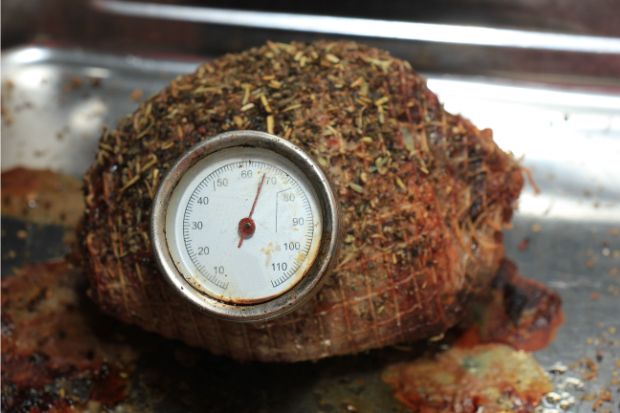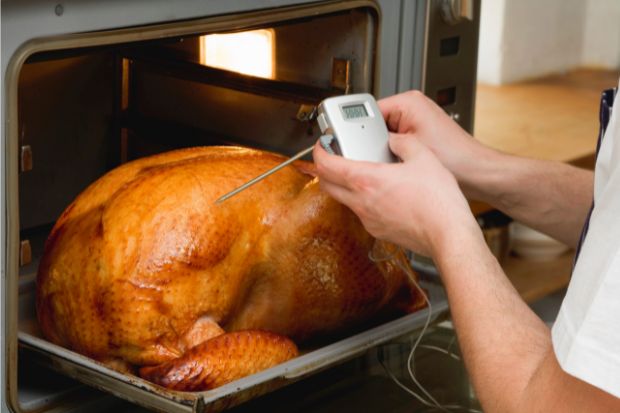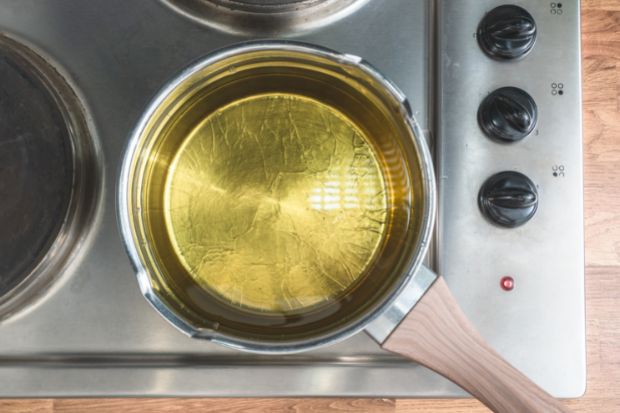When you cook or bake, you often need thermometers to make sure the product you’re working with is hot enough or has achieved the correct doneness. There are many different types of thermometers, and they can be digital or standard.
Can You Use a Meat Thermometer for Oil?
You can use a meat thermometer for oil, provided the thermometer can accommodate the higher temperatures that usually occur when you’re cooking with oil. The temperature range of the thermometer is what you need to check before using it for anything other than its intended purpose.

Types of Kitchen Thermometers
There are numerous types of thermometers, and they can be your standard thermometer or a digital one. Below are the most common types of food thermometers on the market today:
Meat thermometer
A meat thermometer usually has a large dial, in part because it usually remains inside of the piece of meat the entire time it’s cooking and so it needs to be easy to read when you peek in the oven or pot to check it. Most types of meat have to be cooked until they have an internal temperature of between 130 and 175 degrees Fahrenheit. A meat thermometer can also be an instant-read meat thermometer and can be either an analog or a digital thermometer.
Oil or candy thermometers
Using the right candy thermometer is important because candy often requires that sugar be heated up to 300 degrees Fahrenheit. The temperature of oil, on the other hand, might need to get up to 375 degrees Fahrenheit or even higher, which is why it is very important to check the maximum temperature that a particular thermometer can accommodate.
There are other types of thermometers, including deep-fry thermometers and special thermometers made to test the temperature of the oven and even the refrigerator.
How Meat Thermometers and Oil Thermometers Are Different
Whether you’re cooking meat, heating up oil for deep-frying, or cooking sugar to make candy, an accurate reading of the temperature of those foods is a must. You might think that a digital meat thermometer is more accurate than an analog one, but the truth is that both of them are very accurate provided they are made by a reputable manufacturer. In terms of the differences between meat thermometers and oil thermometers, it’s important that you know about the temperature ranges.
Temperature Ranges
Again, it’s imperative that you check the temperature range of the thermometer you’re planning to buy, regardless of the type of thermometer it’s claiming to be. You don’t really need a special thermometer type. You just need an affordable thermometer that can test a range of temperatures for the food items you’re cooking.

Optimal Oil Temperature for Cooking
When you cook with oil, you’re usually frying something. When you’re frying foods such as chicken, the ideal temperature of cooking oil is between 350 and 365 degrees Fahrenheit. If it’s lower than 350 degrees, it will take forever to fry your food and the food could be unsafe to eat. If it’s significantly higher than 365 degrees, it can burn your food on the outside and leave it undone on the inside. If you’re using oil on a pan, it’s important to know that different oils have different smoke points, and the rules get trickier when you mix oils.
Optimal Temperatures for Meat
The proper temperature of meat depends on the kinds of meat you’re cooking. Here are some general rules to follow:
- Ground meats need to be cooked to 160 degrees
- Fresh meats should be cooked to between 145 and 170 degrees (depending on how well done you want them)
- Poultry needs to be cooked to 165 degrees
- Eggs and egg dishes should be cooked to 160 degrees
- Fish and shellfish need a temperature of 145 degrees
- Ham needs to be cooked to 160 degrees
What Type of Meat Thermometer Will Work for Oil?
Many meat thermometers can accommodate temperatures of up to 400 degrees, but you’ll need to check to make sure. You have to cook certain foods to the correct temperature in order for them to be safe to eat. As long as your thermometer can accommodate higher temperatures, it doesn’t matter what type it is.
How Reliable Is It?
Only high-quality thermometers that are made by reputable companies should be used when you’re cooking or frying foods. If the thermometer is too old or has shown a lack of reliability in giving precise readings, don’t use it.
How To Check if Oil Is Ready Without Using a Thermometer
The best way to check the cooking temperatures of oil is to insert either a wooden spoon or a chopstick into the oil and see if it bubbles. If there is steady, consistent bubbling, the oil is hot enough to cook or fry something. If there are barely any bubbles, the oil is not hot enough. If the oil is bubbling feverishly or too aggressively, the oil is too hot. What you want are bubbles that are even and steady, and bubbles that start to float to the top of the pan or pot.
